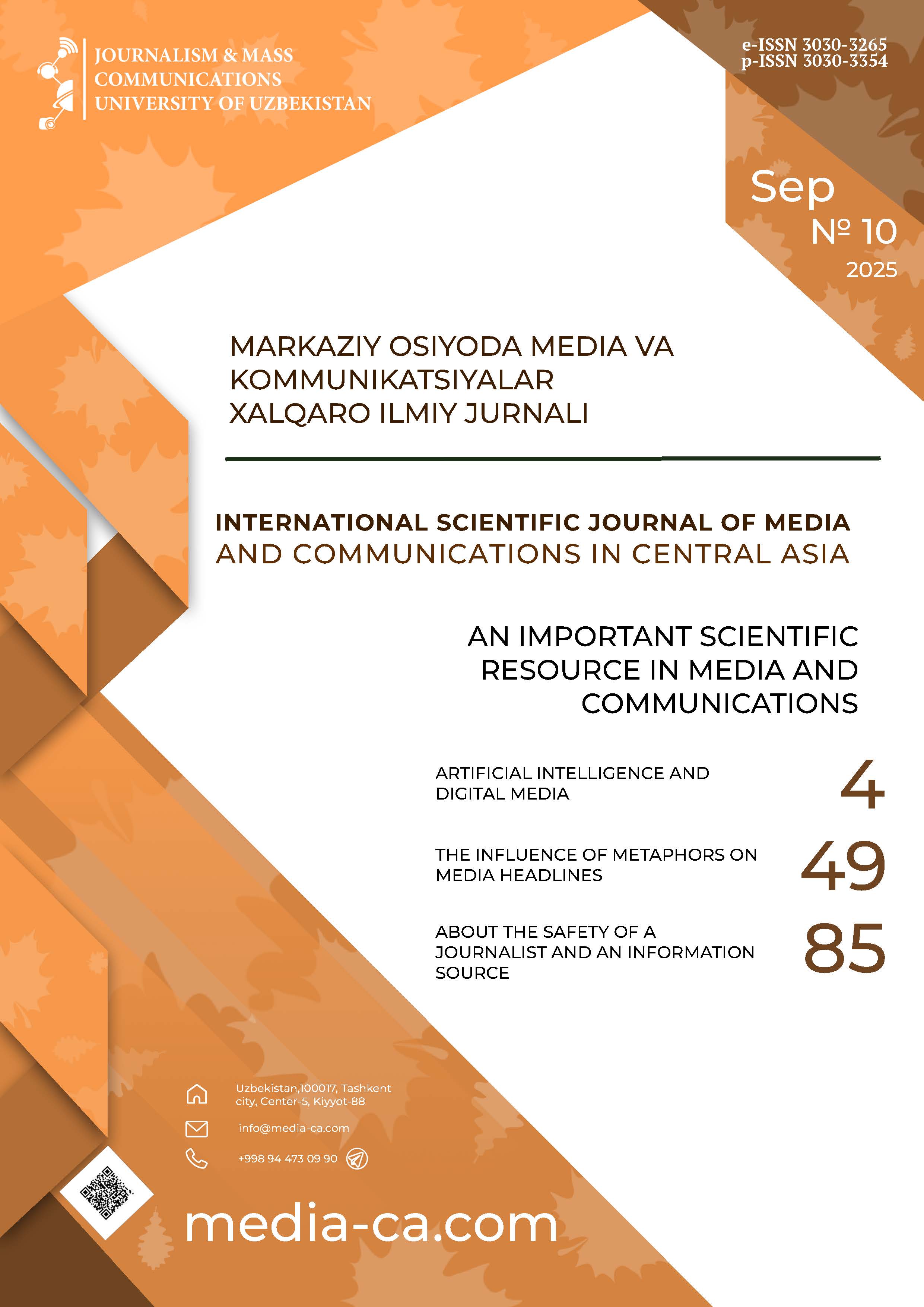APPLICATION OF ARTIFICIAL INTELLIGENCE IN THE DIGITAL MEDIA ENVIRONMENT: ETHICAL RISKS AND REGULATORY MECHANISMS
Published 2025-10-04
Keywords
- Artificial intelligence,
- media ethics,
- digital transformation,
- algorithmic fairness,
- misinformation
- media regulation,
- Uzbekistan,
- journalistic professional ethics ...More
How to Cite
Abstract
This article analyzes the ethical risks associated with the introduction of artificial intelligence (AI) technologies in the digital media environment and examines regulatory mechanisms aimed at mitigating these issues. Based on the analysis of events observed in international and domestic media, key ethical problems were identified, such as the capabilities and limitations of algorithms in decision-making processes, the spread of false information, and breaches of personal data privacy. The study qualitatively analyzed ethical codes, legislative acts, and examples of recent journalistic practices. The results show that while artificial intelligence enhances efficiency in media production and distribution processes, the complex ethical dilemmas associated with it require a balance between technological advancement and social responsibility. The article concludes with proposals to strengthen ethical oversight, ensure transparency, and establish international cooperation.
References
- Call for people to spot deepfakes ahead of election. (2024). BBC News. Retrieved September 09, 2025 from https://www.bbc.com/news/articles/cljl0gd7llxo
- Cazzamatta, R. & Sarısakaloğlu, G. (2024). AI, journalism, and public trust. Journalism Studies, 25(4), 567–583. https://doi.org/10.xxxx/js.2024.0004
- Chesney, R., & Citron, D. (2024). Deepfakes and the new disinformation war. Yale Law Journal, 133(2), 345–412. URL: https://scholarship.law.bu.edu/shorter_works/76/ (Date of application: 15.08.2025).
- Christians, C. G. (2020). Media ethics and social responsibility. New York. Routledge. Retrieved September 09, 2025 from: https://www.taylorfrancis.com/books/mono/10.4324/9780429282249/media-ethics-clifford-christians-mark-fackler-peggy-kreshel-kathy-brittain-richardson
- Clark, R. P. (2005). Red light, green light: A plea for balance in media ethics. Poynter.org. Retrieved September 09, 2025 from: https://www.poynter.org/archive/2005/red-light-green-light-a-plea-for-balance-in-media-ethics/.
- Cunningham, B. (1981). Jimmy’s world and the Pulitzer Prize. The Washington Post. Retrieved September 09, 2025 from: https://ru.scribd.com/document/37178653/Ben-Coulter-Janet-Cooke-Jimmy-s-World.
- Diakopoulos, N. (2019). Automating the news: How algorithms are rewriting the media. Harvard University Press. Retrieved September 09, 2025 from: https://www.asau.ru/files/pdf/2098776.pdf
- Diakopoulos, N. (2014). Algorithmic Accountability: Journalistic investigation of computational power structures. Digital Journalism, 3(3), 398-415. DOI: https://doi.org/10.1080/21670811.2014.976411
- Flaxman, S., Goel, S., & Rao, J. M. (2016). Filter bubbles, echo chambers, and online news consumption. Public Opinion Quarterly, 80(S1), 298–320. https://doi.org/10.1093/poq/nfw006
- Floridi, L., & Cowls, J. (2022). The ethics of artificial intelligence. Oxford University Press. DOI: https://doi.org/10.1093/oso/9780198883098.001.0001
- Helberger, N. (2020). The Political Power of Platforms: How Current Attempts to Regulate Misinformation Amplify Opinion Power. Digital Journalism, 8, 842-854. DOI: https://doi.org/10.1080/21670811.2020.1773888
- Huber, D. S. (2025). Kennzeichnungspflicht bei KI-generierten Inhalten. IT-Recht Kanzlei. Retrieved September 09, 2025: https://www.it-recht-kanzlei.de/kennzeichnung-ki-generierte-inhalte-produkt-fotos-beschreibung.html.
- Johnson, B. (2023). TikTok’s political content algorithm under scrutiny. The Guardian. Retrieved September 09, 2025: https://www.theguardian.com/.
- Kaluža, J. (2021). Habitual Generation of Filter Bubbles: Why is Algorithmic Personalisation Problematic for the Democratic Public Sphere? Javnost – The Public, 29(3), 267–283. DOI: https://doi.org/10.1080/13183222.2021.2003052
- Krippendorff, K. (2019). Content analysis: An introduction to its methodology (4th ed.). Thousand Oaks, CA: Sage. DOI: https://doi.org/10.4135/9781071878781
- The Canon of Journalism. (2023). Pressnet. Japan Newspaper Publishers and Editors Association. Retrieved September 09, 2025 from: https://www.pressnet.or.jp/english/about/canon/.
- Pariser, Y. (2011). The filter bubble: What the Internet is hiding from you. New York: Penguin Press. Retrieved September 09, 2025 from: https://hci.stanford.edu/courses/cs047n/readings/The_Filter_Bubble.pdf
- Penenberg, A. L. (1998). Hack heaven: The Stephen Glass case. Forbes. Forbes.com. Retrieved September 09, 2025 from: https://www.forbes.com/1998/05/11/otw3.html.
- Ward, S. J. A. (2021). Ethics and the media: An introduction. Cambridge: Cambridge University Press. Retrieved September 09, 2025 from: https://philpapers.org/rec/WAREAT-9
- West, D. M., & Allen, J. (2018). How Artificial Intelligence Is Transforming the World. Brookings. Retrieved September 09, 2025 from: https://www.brookings.edu/research/how-artificial-intelligence-is-transforming-the-world/.
- White, A. & Elliott, C. (Eds.). (2018). Trust in ethical journalism: The key to media futures. Ethical Journalism Network. Aidan White and Chris Elliott. Retrieved August 17, 2025, from https://ethicaljournalismnetwork.org/wp-content/uploads/2021/11/Trust-in-Ethical-Journalism-1.pdf
- Vlăduțescu, Ș., & Stănescu, G. C. (2025). The Role of Artificial Intelligence in Romanian Broadcasting: Opportunities and Challenges. Journalism and Media, 6(1), Article 22. https://doi.org/10.3390/journalmedia6010022
- Do‘stmuhammad, X. (2007). Jurnalistning kasb odobi muammolari: nazariy-metodologik tahlil. Toshkent: Yangi asr avlodi. 212 b.
- Mirziyoyev, Sh. (2024). Sun’iy intellekt texnologiyalarini 2030-yilga qadar rivojlantirish strategiyasini tasdiqlash to‘g‘risida. O‘zbekiston Respublikasi Prezidentining Qarori . Lex.uz. https://lex.uz/docs/-7158604 2025-yil 03-sentabrda olindi
- Mo‘minov, F. (2015). Jurnalistika ijtimoiy institut sifatida. Toshkent: Universitet nashriyoti. 2025-yil 03-sentabrda olindi https://conferences.uz/plugins/themes/bootstrap3/pdf/conf_28_2021/6.Jurnalistika_3_qism.pdf
- Qudratxo‘ja, Sh. T. (2024). Sun’iy intellekt jurnalistikada insonning o‘rnini bosa olmaydi. International journal of media and communications in Central Asia. 2025-yil 03-sentabrda olindi https://uza.uz/oz/posts/suniy-intellekt jurnalistikada-insonning-ornini-bosa-olmaydi_628115
- Yuldashev, I. (2024). Algoritmlar va O‘zbekiston mediasi. Gazeta.uz. 2025-yil 03-sentabrda olindi https://www.gazeta.uz/ 2025-yil 03-sentabrda olindi.


